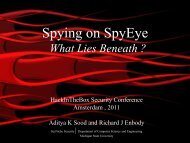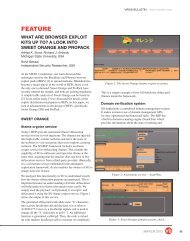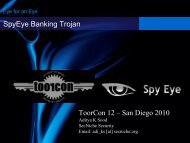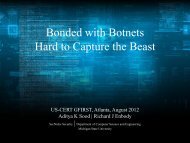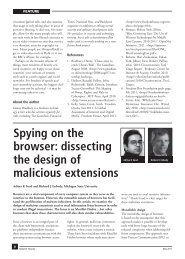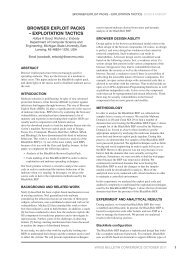Dissecting Java Server Faces for Penetration Testing - SecNiche ...
Dissecting Java Server Faces for Penetration Testing - SecNiche ...
Dissecting Java Server Faces for Penetration Testing - SecNiche ...
- No tags were found...
You also want an ePaper? Increase the reach of your titles
YUMPU automatically turns print PDFs into web optimized ePapers that Google loves.
a large scale. A number of websites using JSF in a real time environment arestill vulnerable and are running in default insecure state. The ViewState encryptionstrength in JSF can be checked using POET as discussed. The toolverifies whether the encryption is applied or not. If it is applied, then it has aninbuilt module to decrypt the ViewState using oracle padding. The tool followsthe concept of tampering a single byte in the encrypted JSF ViewState (lastblock) to verify whether ViewState padding is done appropriately or not basedon HTTP error fingerprinting. JSF usually ignores the inserted block duringserialization which helps the tool to go on decrypting the ViewState withoutany hassles. The practical usage of tool can be seen here [9].4.2.1 Experiment - Fuzzing OracleWe conducted a number of tests on one of the vulnerable websites to show theimpacts of the padding oracle. The tests are based on manual fuzzing. The aimis to present the variation in the error responses when encrypted ViewState istampered. One thing that should be taken into account while per<strong>for</strong>ming thistest is that ViewState has to be encrypted. The test should not be executedagainst ViewState that is compressed using GZIP. In addition, the ViewStateshould be fuzzed using multiples of 8 because the block size that is used in CBCencryption has a similar technique. The nature of a response to a padded buffervaries between applications.Step 1: Injecting random buffer in ViewState as a multiple of 8. Figure 5shows how the application reacts.Step 2: At this point, we got a crypto padding error in step 2, on continuousplaying around with padding in ViewState; we received different error aspresented in figure 6.Considering this scenario, one can continue fuzzing the request, until it isaccepted by the application. There is a typical way of doing padding in CBCand that can be used in all scenarios as discussed here [11]. One can opt <strong>for</strong>various methods to pad CBC encryption.4.3 JSF Anti CSRF - Truth Behind the ScenesIn reality, JSF does not have an aggressive built-in CSRF protection. AntiCSRF support is required <strong>for</strong> protection against Cross Site Request Forging(CSRF) attacks. However, the implementation of anti CSRF depends a lot onthe design of he in the required framework. ViewState is used <strong>for</strong> preserving thestate of web pages and can be used in conjunction with another configurationparameters to prevent CSRF attacks. However, one can per<strong>for</strong>m certain logictests to initially detect whether the application is vulnerable to CSRF attacksor not.11




